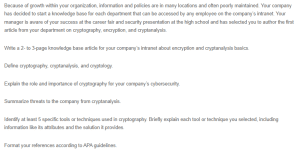Cryptography Knowledge Base Article
As the company starts creating a knowledge base, it is important to write an article about cryptography, encryption, and cryptanalysis basics. This topic is of paramount significance concerning the security of organizations’ information technology resources, and the protection, integrity, and accessibility of significant data.
Cryptography is the technique of ensuring that the data transmitted or stored cannot be understood or manipulated by any unauthorized person. It entails the development of protocols that would keep private information from being read by other parties. On the other hand, cryptology involves the analysis of the principles of creating codes and ciphers, and cryptanalysis concerns the examination of information systems to investigate the covert properties of the systems. It involves decoding techniques used in encryption to recognize possible vulnerabilities within it (Mihailescu & Nita, 2023). Cryptology incorporates both cryptography and cryptology based on the spectrum of secure communication and information protection.
Importance of Cryptography for Cybersecurity
Cryptography serves as an indispensable tool for protecting business information within the company and maintaining the confidentiality, integrity, and authenticity of our data in the context of the organization’s cybersecurity. It is the basis for ensuring the confidentiality of certain information, such as financial information, customer data, trade secrets, and other information that should not be disclosed to third parties. Through encryption, data is converted into a form that is not easily understood by everyone, but the intended users have the capacity to decode the encrypted data through decryption keys. Besides protecting the data from being compromised, it also strengthens the level of security for the messages and other activities that take place online.
Threats from Cryptanalysis
Even though cryptography can effectively protect data, cryptanalysis remains a threat to the company. Cryptography protects data from hackers, and some of those hackers skilled in cryptanalysis may try to decipher cryptographic algorithms, resulting in the exposure of valuable data. This could cause loss of information, money, image, and compliance with the law among the organizations. It is, therefore, important to comprehend the approaches and methods applied in cryptanalysis to avoid falling victim to such attacks or to design the most potent countermeasures necessary to protect the data your firm transmits through encryption.
Cryptographic Tools and Techniques
To deal with the threats posed to the system, the company can utilize various cryptographic tools and techniques. An example is secret-key encryption, also called symmetric-key encryption, where both the sender and receiver employ the same secret key for decryption and encoding purposes. One of the well-known symmetric algorithms is the Advanced Encryption Standard (AES), which is widely adopted for its security and efficiency. In asymmetric-key encryption or public-key cryptography, the system uses two keys, a public key for encrypting the data and a private key for decrypting the data. This process enables it to be secure, yet there will be no need to share a secret key. RSA and Elliptic Curve Cryptography (ECC) are classified under the asymmetric-key algorithms. Another cryptographic technique is hashing, which maps a given data with a known length into an entirely unique value of a fixed length known as a Hash value or a message digest. Generally, hashing is employed to confirm data integrity and protect passwords and digital signatures. Some examples of hashing algorithms include SHA-256 and MD5.
Furthermore, digital signatures employ the principles of asymmetric-key cryptography and offer services such as authentication, non-repudiation, and document integrity for digital documents and messages. It warrants that the sender is the one who is details depicted in the message and that the message has not been interfered with. Diffie-Hellman and Transport Layer Security (TLS) are other examples of key exchange protocols which allow two users to agree to share certain secret without having to actually transfer it over a communication path.
References
Mihailescu, M. I., & Nita, S. L. (2023). Getting Started in Cryptography and Cryptanalysis. In Pro Cryptography and Cryptanalysis with C++23 (pp. 3–18). Apress, Berkeley, CA. https://doi.org/10.1007/978-1-4842-9450-5_1
ORDER A PLAGIARISM-FREE PAPER HERE
We’ll write everything from scratch
Question
Because of growth within your organization, information and policies are in many locations and often poorly maintained. Your company has decided to start a knowledge base for each department that can be accessed by any employee on the company’s intranet. Your manager is aware of your success at the career fair and security presentation at the high school and has selected you to author the first article from your department on cryptography, encryption, and cryptanalysis.

Cryptography Knowledge Base Article
Write a 2- to 3-page knowledge base article for your company’s intranet about encryption and cryptanalysis basics.
Define cryptography, cryptanalysis, and cryptology.
Explain the role and importance of cryptography for your company’s cybersecurity.
Summarize threats to the company from cryptanalysis.
Identify at least 5 specific tools or techniques used in cryptography. Briefly explain each tool or technique you selected, including information like its attributes and the solution it provides.
Format your references according to APA guidelines.

